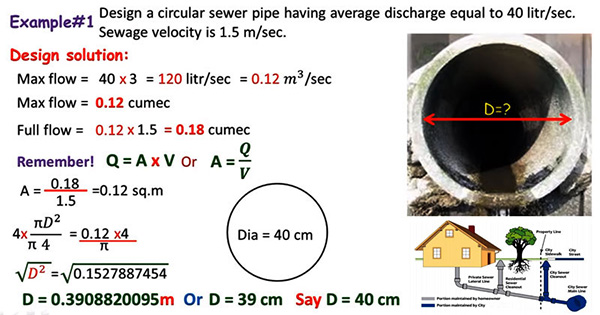Layout and Design of Sewer Pipe

In this civil engineering video tutorial, the renowned engineer S.L. Khan, shares some useful tips to create the design of any circular sewer pipes easily.
The tips are based on the solution of the following example:-
Design a circular sewer pipe with average discharge identical to 40 litre/sec. Sewage velocity is 1.5/sec.
Design solution is given below:-
As maximum flow is equivalent to average discharge, so, we can write:-
Max Flow = 40 x 3 = 120 litre/sec (3 is a multiplying factor to change average discharge into maximum discharge).
120 litre = 0.12 m3/sec (divide with 1000 for converting to cubic meter).
So, maxium flow = 0.12 cumec (cubic meter is also known as cumec)
But the above flow will allow sewer pipe to flow upto 2/3 and it is necessary to design the sewer for full flow.
So, full flow = 0.12 x 1.5 = 0.18 cumec (as 3/2 = 1.5)
With this flow, the diameter of the pipe can be determined.
We know that Discharge = Cross Section Area x Velocity
So, Q = A x V
Now, divide both sides with velocity to get the following result:-
A = Q / V = 0.18 / 1.5 = 0.12 sq.m (discharge = full flow; velocity = 1.5 m/sec)
As the value of area = πD2/4
So, πD2/4 = 0.12
Now, multiply both sides with 4 and π.
So, 4 x πD2/π4 = 0.12 x 4 / π
So, D2 = 0.1527887454
To get the value of D, put square root on both sides.
So, √D2 = √0.1527887454
So, D = 0.3908820095m or 39 cm or 40 cm (approx)
So, diameter of sewer pipe = 40 cm
To get more detail information, go through the following exclusive video tutorial.
Video Courtesy : Engineer Boy

